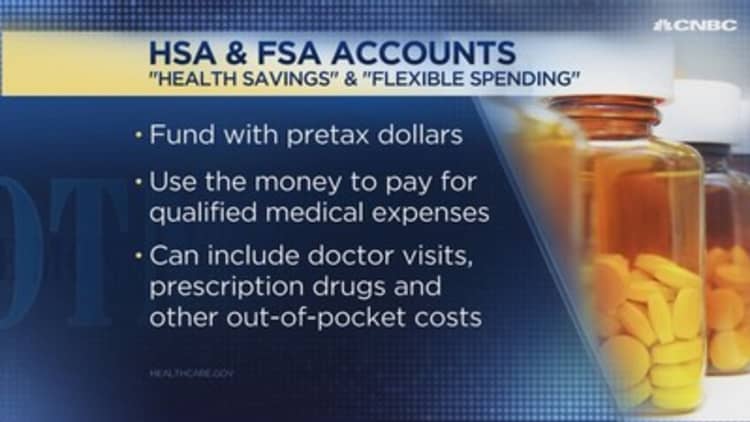Over the past three months, many doctors, dentists and optometrists have deferred non-emergency appointments and exams because of the coronavirus pandemic. But for many Americans, that means the funds they set aside for these routine health expenses have been languishing unused in flexible savings accounts.
They may get a break. Last month, the IRS announced that it would allow employees to make mid-year changes to their health care benefits. Under the new guidelines, employees can change health insurance plans and sign on for a plan if they previously waived coverage, as well as alter contribution levels to the health and dependent care FSA plans.
This is important because typically, FSA accounts operate under use-it-or-lose-it rules. You're supposed to spend everything you put in the account within the calendar year, or else you could lose the money. In 2019, employees were allowed to make a maximum contribution to a health care FSA of $2,700; for 2020 the limit was upped to $2,750. Some employers allow you to spend the money through the first few months of the next year or carry forward up to $500, but others are more strict.
Normally, employees are only allowed to make changes to their health benefits once a year, during open enrollment. But 2020 is shaping up to be anything but an ordinary year, so the IRS has allowed mid-year changes in order to keep Americans from losing money because they weren't able to spend their balances.
There's one one big caveat to the new IRS rules: It's up to employers to decide whether or not to allow these mid-year changes. The IRS notice says that employers are not required to provide unlimited changes and the employer can set a timeframe to make changes, such as only permitting changes during the month of September, says Chatrane Birbal, vice president, public policy, for the Society for Human Resource Management.
Who's allowing changes
When it comes to permitting employees to make mid-year changes to their health benefits, it's going to vary from employer to employer, Birbal says. "If there is a smaller employer, maybe they would allow unlimited changes to the plan throughout the year," she says. "I could see larger companies with more employees on their plans setting more parameters in place."
About 1 in 3 employers say they're planning to allow employees to make mid-year changes to their health FSA plans, according to early results from a poll of roughly 100 companies that benefits consulting firm Mercer launched Monday. The results are as of Tuesday morning and the poll will be open through the end of June.
Source: Mercer
Nearly half of employers are planning to allow changes to dependent care FSA plans, which have a contribution limit of $5,000 per year for individuals or married couples filing jointly, or $2,500 for a married person filing separately.
About 12% of employers plan to allow employees to change their health-care plan or enroll in one after waiving coverage, the survey found.
"We don't yet know how many employers will take advantage of a second open enrollment opportunity this year," says Alison Moore, a vice president with health savings account provider HealthSavings Administrators. In an earlier survey that Moore's company fielded, only about 9% of employers indicated they are considering changes to benefits because of the coronavirus pandemic.
Some employers already opted to allow employees into their health plans in the earliest days of the pandemic. In fact, SHRM sent letters to the IRS and Congress earlier this year asking for changes to rules around health plan enrollment and FSA contributions.
"The issue was raised to us by SHRM members who indicated that if they had clear guidance that they would be open to allowing these changes — it was just that they needed to have the guidance from the IRS," Birbal says.
What to consider if you want to make a change
For those looking to update their health care benefits, it's worth taking the time to carefully consider how your needs have changed since you first picked out your health benefits and set your contribution level, as well as whether you expect your needs to change again before the end of the plan year, says Katharine Marshall, a principal with Mercer's law and policy group. "Employees should be careful not to make an election change now that they might want to change again later, but can't."
When it comes to FSA contributions, it may make sense for many Americans to reduce how much money they're putting into their accounts, especially if they haven't had the routine appointments they planned or if they're one of the 60% of parents who have no child care during the pandemic. In that case, it probably doesn't make sense to continue to contribute to a dependent care FSA, especially if you've already hit the carryover limit and you're unsure if you'll need child care for most of the year, Birbal says.
And those whose hours were reduced or who took a salary cut may now need extra money in their pocket, Birbal says.
In addition to decreasing FSA contribution levels, it may be a good opportunity to evaluate your health insurance plan as a whole. Employees who have been furloughed or suffered pay cuts may be looking for opportunities to decrease their expenses, including their insurance premiums, Moore says. Opting for a high deductible plan decreases the amount of money that needs to come out of your paycheck to pay health plan premiums.
"Now would be a good time to evaluate your current insurance, decide if you think you will incur enough medical expenses to justify the premium and determine the best option for your current financial situation," Moore says.
Check out: The best credit cards of 2020 could earn you over $1,000 in 5 years
Don't miss: Americans are spending down their annual HSA dollars, using most of it just to see doctors



